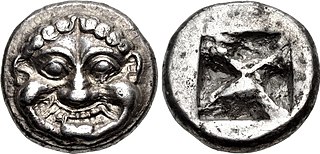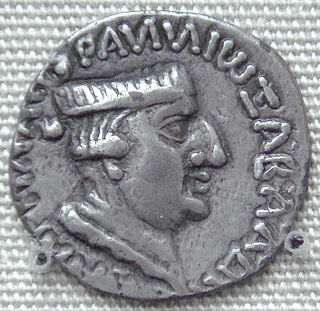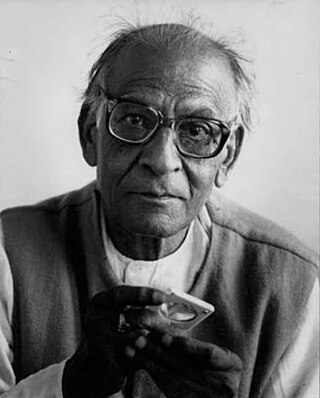
The history of ancient Greek coinage can be divided into four periods: the Archaic, the Classical, the Hellenistic and the Roman. The Archaic period extends from the introduction of coinage to the Greek world during the 7th century BC until the Persian Wars in about 480 BC. The Classical period then began, and lasted until the conquests of Alexander the Great in about 330 BC, which began the Hellenistic period, extending until the Roman absorption of the Greek world in the 1st century BC. The Greek cities continued to produce their own coins for several more centuries under Roman rule. The coins produced during this period are called Roman provincial coins or Greek Imperial Coins.

Chhatrapati is a royal title from Sanskrit used to denote a king. The word "Chhatrapati" is a Sanskrit language compound word of chhatra and pati (master/lord/ruler). This title was used by the House of Bhonsle, between 1674 and 1818, as the heads of state of the Maratha Confederacy.

The Coinage of India began anywhere between early 1st millennium BCE to the 6th century BCE, and consisted mainly of copper and silver coins in its initial stage. The coins of this period were Karshapanas or Pana. A variety of earliest Indian coins, however, unlike those circulated in West Asia, were stamped bars of metal, suggesting that the innovation of stamped currency was added to a pre-existing form of token currency which had already been present in the Janapadas and Mahajanapada kingdoms of the Early historic India. The kingdoms that minted their own coins included Gandhara, Kuntala, Kuru, Magadha, Panchala, Shakya, Surasena, Surashtra and Vidarbha etc.

The Satavahanas, also referred to as the Andhras in the Puranas, were an ancient Indian dynasty. Most modern scholars believe that the Satavahana rule began in the late second century BCE and lasted until the early third century CE, although some assign the beginning of their rule to as early as the 3rd century BCE based on the Puranas, but uncorroborated by archaeological evidence. The Satavahana kingdom mainly comprised the present-day Andhra Pradesh, Telangana, and Maharashtra. At different times, their rule extended to parts of modern Gujarat, Madhya Pradesh, and Karnataka. The dynasty had different capital cities at different times, including Kotalingala (Telangana), Pratishthana (Paithan) and Amaravati (Dharanikota).
The Western Satraps, or Western Kshatrapas were Indo-Scythian (Saka) rulers of the western and central parts of India, between 35 and 415 CE. The Western Satraps were contemporaneous with the Kushans who ruled the northern part of the Indian subcontinent, and were possibly vassals of the Kushans. They were also contemporaneous with the Satavahana who ruled in Central India. They are called "Western Satraps" in modern historiography in order to differentiate them from the "Northern Satraps", who ruled in Punjab and Mathura until the 2nd century CE.

Nahapana, was an important ruler of the Western Kshatrapas, descendant of the Indo-Scythians, in northwestern India, who ruled during the 1st or 2nd century CE. According to one of his coins, he was the son of Bhumaka.

The American Numismatic Society (ANS) is a New York City-based organization dedicated to the study of coins, money, medals, tokens, and related objects. Founded in 1858, it is the only American museum devoted exclusively to their preservation and study. Its collection encompasses nearly one million items, including medals and paper money, as well as the world's most comprehensive library of numismatic literature. The current President of the Society, Dr. Ute Wartenberg, served as the Executive Director for two decades and was succeeded in this role by Dr. Gilles Bransbourg.

Bhartrdaman was a Saka ruler of the Western Kshatrapas in northwestern India from around 278 to 295. For the first four years, his coins name him only as kshatrapa, after which time his coins name him mahakshatrapa. He was the second of two sons of Rudrasena II who came to the throne, after his brother Visvasimha, and was among the last rulers of the Kardamaka dynasty.
Philip Grierson, was a British historian and numismatist. He was Professor of Numismatics at Cambridge University and a fellow of Gonville and Caius College for over seventy years. During his long and extremely prolific academic career, he built the world's foremost representative collection of medieval coins, wrote very extensively on the subject, brought it to much wider attention in the historical community and filled important curatorial and teaching posts in Cambridge, Brussels and Washington DC.

Nicholas Gervase Rhodes was a British numismatist who specialised in the coinages of Asia, particularly those of Himalayan kingdoms and pre-Communist Tibet.

Joe Cribb is a numismatist, specialising in Asian coinages, and in particular on coins of the Kushan Empire. His catalogues of Chinese silver currency ingots, and of ritual coins of Southeast Asia were the first detailed works on these subjects in English. With David Jongeward he published a catalogue of Kushan, Kushano-Sasanian and Kidarite Hun coins in the American Numismatic Society New York in 2015. In 2021 he was appointed Adjunct Professor of Numismatics at Hebei Normal University, China.
Jabir Raza is an Indian historian, and a researcher in the history stream. Presently, he is retired, used to work as a professor at the department of history and prior to that was working as a lecturer at Department of History in Women's College of Aligarh Muslim University. He is from Nalanda, Bihar.
Silk Road Numismatics is a special field within Silk Road studies and within numismatics. It is particularly important because it covers a part of the world where history is not always clear – either because the historical record is incomplete or is contested. For example, numismatics has played a central role in determining the chronology of the Kushan kings.
Nicholas Manning Lowick (1940-1986) was a leading specialist in Islamic numismatics and epigraphy at the British Museum.
Henry Nelson Wright (1869-1941) was a British civil servant in India and a numismatist, specialising in Indian numismatics, for which he is best known.
David Michael Metcalf was a British academic and numismatist. He was the director of the Heberden Coin Room of the Ashmolean Museum, a fellow of Wolfson College and Professor of Numismatics at the University of Oxford. He held the degrees of MA, DPhil and DLitt from Oxford.

Parmeshwari Lal Gupta was an Indian numismatist who collated previous research on Indian Numismatics in the post-Independence era.

Ute WartenbergFSA is a German numismatist and the first woman president and executive director of the American Numismatic Society (ANS). Wartenberg serves as an adjunct professor of classics at Columbia University and as the curator of the Amastris Collection, a private collection of Greek coins.

Haim Gitler is an Israeli curator and researcher, specializing in the field of numismatics. He is chief curator of archaeology and curator of numismatics at the Israel Museum, Jerusalem, as well as the President of the Israel Numismatic Society.













